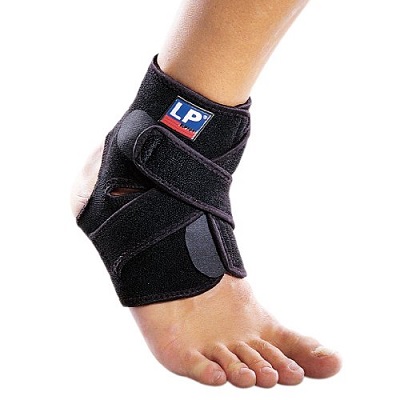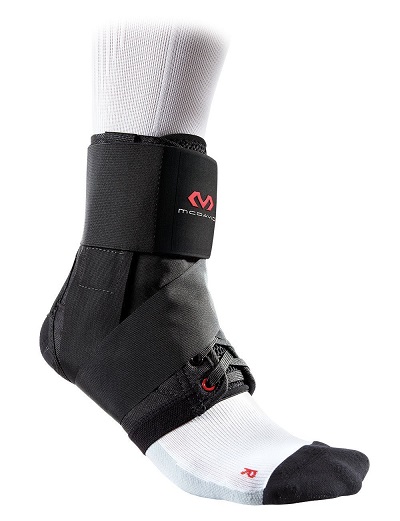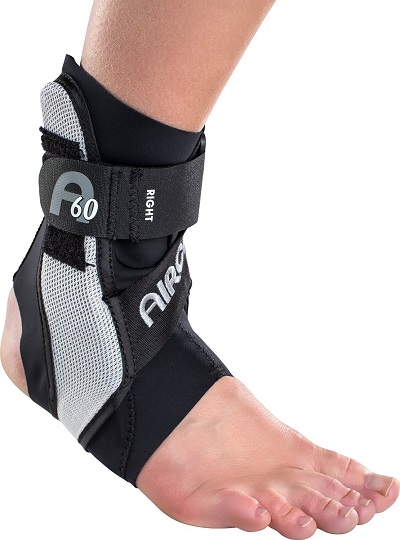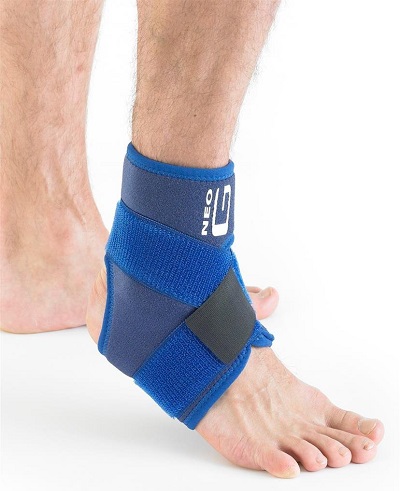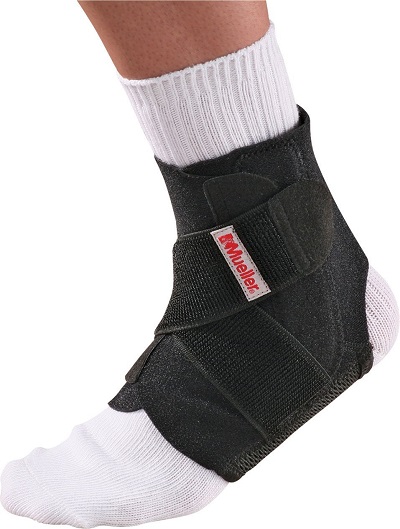Ankle injuries can be quite painful and uncomfortable. They also prevent full range of motion, which can be especially problematic for athletes. An ankle brace support, while it cannot prevent an ankle injury, can be very helpful in healing one. By providing compression and support, a good ankle brace will help improve your movement while also shortening your recovery time.
We looked at several types and brands of ankle braces available in the market, comparing them in areas such as ease of use, level of support and healing time. Here are the top five ankle braces we found.
Best ankle brace support reviews
1. LP Extreme Ankle Support
This brace uses a Velcro design to strap securely around the ankle and heel. This helps provided adequate compression and support to the injured ankle. This design also allows the brace to fit different ankle sizes without compromising support.
The brace is made from a material called CoolPrene. Designed by medical experts, CoolPrene contains grooves and holes designed to release excess heat and moisture. This allows one to wear the brace for long without experiencing uncomfortable heat and perspiration.
Pros
- Unique velcro design for added support and a versatile fit.
- Uses special material that reduces heat and moisture buildup.
- Comfortable to wear even over prolonged periods.
Cons
- Cannot be worn with tight-fitting shoes.
2. McDavid Light Ankle Brace with Figure-8 Strap
This brace comes with a special ‘figure 8’ strap design. The straps wrap around both the ankle and the heel and are designed to imitate professional taping, providing necessary support especially during movement. For added stability, there is a special inner lining designed to support the arch. A ventilated tongue provides breathability for extended comfort.
Pros
- The brace has been designed in such a way that it can be used on either the left or right ankle.
- The ‘figure 8’ strap design is highly effective at providing support.
- Made from a durable material that can withstand repeated athletic use.
- You can adjust brace without removing the shoe.
Cons
- Cannot be worn with tight-fitting shoes. Look for shoes half a size bigger than your usual size.
3. Aircast A60 Ankle Brace
Similar to a brace once worn by tennis star Andy Murray, the Aircast A60 is perfect for ankle rehabilitation. It extends a bit above the ankle for added stability and compression. Straps extend around the ankle and heel to ensure balanced support. The heel and toes are left open to ensure that the wearer still enjoys freedom of movement.
Pros
- Perfectly balances between compression support and motion flexibility.
- Made from a breathable material.
Cons
- It is not a one-size-fit-all. With different sizes available, many customers end up ordering the wrong size.
4. Neo G Medical Grade VCS Ankle Support
This ankle support is great for strained and sprained ankles. It also helps with weak and arthritic ankles. Whether you are looking for something to help you in sports or everyday walking, the Neo G brace is great. A ‘figure 8’ strap design emulates professional sports taping, ensuring adequate support for the ankle. The brace is made from Neoprene, which helps warm muscles and joints for added therapeutic benefits.
Pros
- Works well at providing required support and compression for weak and injured ankles.
- Uses neoprene, which has additional therapeutic benefits to leg muscles and joints.
Cons
- Not ideal for serious ankle injuries such as grade 3 sprains. Works best for mild sprains and strains.
5. Mueller 44547 Ankle Stabilizer
In addition to the ‘figure 8’ straps, this brace also includes side stays, which provided added lateral support and stability for your foot. AEGIS Microbe Shield, a type of fabric enhancement, is added to keep the brace odour and microbe free.
Pros
- A one-size-fits-all design. Works well with UK shoe sizes 3 to 14.
- The fabric used is antibacterial, which helps keep it clean and minimize odours.
Cons
- Ideal for mild strains and sprains but not for more serious (grade 2 and 3) ankle injuries.
Key buying considerations
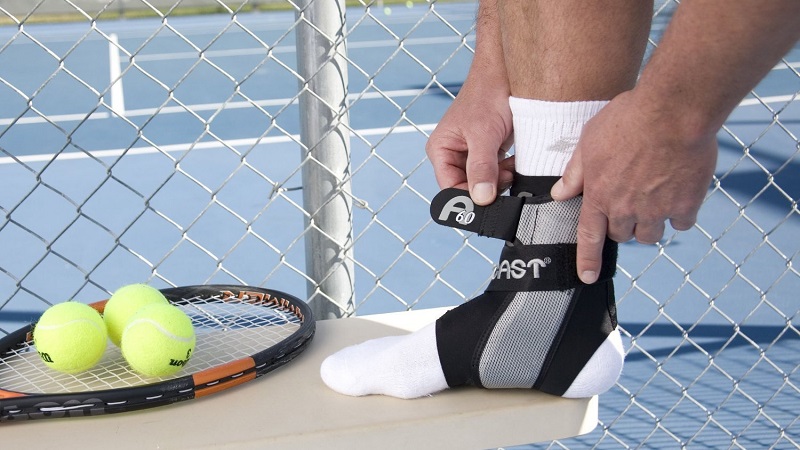
In coming up with the best ankle braces, we came across numerous designs and types. As a buyer, choosing the best one for your needs can be a bit confusing. To help make the best purchase decision, here are the most important considerations you should make.
- Ease of use – if you have to spend more than a few minutes strapping on the brace, it is probably too complicated and unfriendly. Look for a brace with a simple but effective strap design. Many braces employ a ‘figure 8’ strap design that is easy to sue and provides adequate support.
- Proper support and compression – look at what customers are saying. Does the brace provide enough support? Some braces are designed only to support mild ankle injuries while others have added support for more serious injuries. Make sure your preferred brace has the right level of support for your ankle.
- Breathable – there is nothing more uncomfortable than a brace that leaves your foot baking in heat and filled with sweat. A good brace should have a breathable material that allows heat and perspiration to escape.
- Size – this is where many buyers get it wrong, with many buying a brace that is too small. If a brace is not one-size-fits-all, make sure you choose the right size for your foot.
FAQs
Does an ankle brace prevent ankle injury?
No. Ankle braces are not designed to prevent ankle injuries. Rather, they are designed to compress and support an injured ankle to speed up healing, improve mobility and prevent injury deterioration.
Can I wear an ankle brace together with shoes?
Yes. Many ankle braces are designed to be worn together with shoes, usually sports shoes. In many cases, you have to use shoes that are a bit bigger than usual to ensure a comfortable fit.
Can I keep playing or running with an ankle brace on?
Yes, you can. One of the main benefits of ankle braces is that they allow one to keep moving, running and playing. So whether it is football, tennis, volleyball or any other sports, you should enjoy yourself despite wearing an ankle guard.
You just need to be extra careful about protecting your ankle. For very serious ankle injuries however, or if you experience increasing pain when playing, consult your doctor before getting back into the field.
How long should I wear an ankle brace after a sprain?
You should keep wearing an ankle brace as long as you are still feeling pain and your ankle is swollen or unstable.
Depending on the severity of the sprain (from stretched ligaments with mild pain to torn ligaments with severe pain), you may have to wear an ankle brace anywhere from 10 days to six weeks.
After a sprain, some people opt to keep wearing an ankle sprain as a preventive measure, especially during intensive activities like running or basketball. This reduces the risk of a future injury.
How to wear an ankle brace?
Because ankle brace design varies slightly between brands, check the leaflet or manual that’s included with your brace for specific directions.
Most ankle braces consist of the main part that you slip your foot through and straps that go under your heel and behind your ankle.
Here are the general steps for wearing an ankle brace.
- Loosen all straps and laces (if wearing a laced brace).
- Insert your foot into the brace, making sure you position it properly. To wear it right, sit down and place your foot on the floor.
- If you have a laced brace, tighten the lacing until the brace feels snug. To tighten pull the lacing starting from the bottom and work your way upwards as it tightens. Some braces have a lace-tightening dial that you turn to tighten the laces.
- Wrap the straps around your ankle to complete the setup. Most braces have two long straps that wrap around the front of the ankle (one on each side), under the foot and up on the side of the ankle. They form an 8-figure pattern.
- Other braces have a short strap that secures the brace at the top and another long one that wraps around your foot and ankle in an 8 pattern.
- Adjust the straps until the brace feels comfortable. It should be snug but not overly tight.
You can wear the brace with your shoes, though you may need to get new shoes that are half a size bigger.
If you want to wear socks, wear them underneath the brace. Put on the socks first then secure the brace on top.
How to make a homemade ankle brace?
The easiest way to make a homemade ankle brace is using bandage from your first aid kit.
Sit down and place your leg on the floor in a 90-degree angle. Take the rolled up bandage and begin wrapping over the ball of your foot where toes meet the foot.
Wrap the bandage around your foot several times until you reach the arch. Just before you get to the heel, pull the bandage up diagonally and wrap it around your ankles then back down under your arch in a figure 8 pattern.
Repeat this pattern, moving from wrapping the bandage around your foot to wrapping it around your ankles until you get to the end of the bandage.
Secure the bandage using a clip or Velcro (if it has a Velcro patch at the end).
Be careful not to tighten the bandage too much as that could affect blood flow and hurt your ankle further.
Once you’ve completed the brace, you should be able to walk slowly without moving your ankle.
Conclusion
Instead of just wrapping a piece of cloth around your injured ankle, buy an ankle brace support. It provides better ankle and foot support and allows you to heal faster and get back to full health.

